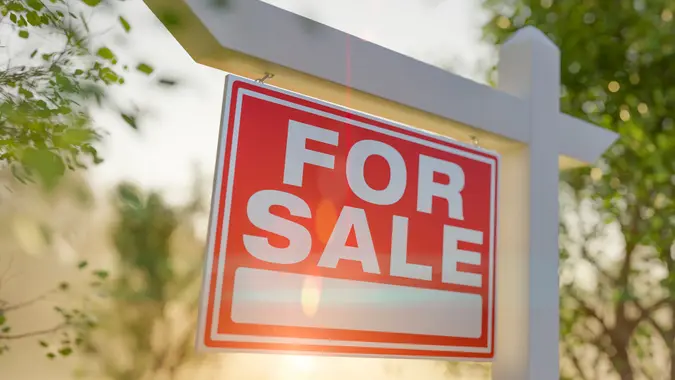How US Home Values Have Changed Over the Last 20 Years

Commitment to Our Readers
GOBankingRates' editorial team is committed to bringing you unbiased reviews and information. We use data-driven methodologies to evaluate financial products and services - our reviews and ratings are not influenced by advertisers. You can read more about our editorial guidelines and our products and services review methodology.

20 Years
Helping You Live Richer

Reviewed
by Experts

Trusted by
Millions of Readers
Home prices and mortgage rates are traditionally thought of as relatively stable and slow-growing, more or less keeping up with the rate of inflation while exhibiting little volatility. Older generations like baby boomers or Gen X can attest to this, but over the past 20 years or so, buying and selling a home has been anything but a sure thing in the United States.
In fact, over the past two decades, home values, mortgage payments and housing costs in general have undergone two distinct — and opposite — periods that aren’t generally associated with the housing market. There was a period of negative returns and a period of double-digit returns, both over a relatively short timeframe.
Using expert real estate agent analysis and data from Zillow, here’s a look at how U.S. home values have changed over the last 20 years.
General Trends Over the Past 20 Years
While there have been periods of rising and falling home values, the end result is this: In the past 20 years, the average home price in the U.S. has grown from about $140,000 to about $503,800 as of 2025.
Thanks to certain tariffs on imports, the supply and demand of building materials could also greatly impact pricing over the next couple of years when you buy a home.
The Great Decline: 2006-2012
Typical home prices rose dramatically from 2003 and 2006, but the party ended with The Great Recession and the housing price meltdown over the ensuing five to six years.
As well-documented both in the financial press and in movies such as “The Big Short,” housing prices were artificially inflated in the years running up to The Great Recession. Adjustable-rate loans were handed out to underqualified buyers with little to no documentation.
So, when interest rates climbed higher, many of these homeowners defaulted, dragging down the housing and banking industries and nearly taking down the entire U.S. economy as well as millions of credit scores. This combination of economic factors took years to work itself out, and home prices continued to fall even after the economy as a whole dug its way out of the recession.
Ultimately, the average home value in the U.S. fell by about 33%, nearly eliminating all the gains they had experienced from 2003 to 2006. That effectively made this era in real estate, “the lost decade,” in which housing prices and home sales hardly gained at all.
The Booming Recovery, 2012-2025
After all the excesses had been wrung out of the U.S. housing market, dragging the home price index far below what many considered “fair,” a boom period followed over the next decade, reaching a fever pitch from 2020 to 2022 and regulating without dipping too much from 2023 to the present.
In 2012, Zillow announced that U.S. home values had bottomed. Prices in the second quarter of 2012 increased by 0.2% since the second quarter of 2011, the first year-over-year gain since 2007. At the time, the average home price in the U.S. was just $149,300.
As of the third quarter of last year, the median home sales price is $420,400, which is a 25% increase from the third quarter of 2020, when the median sales price was $337,500, according to the data from the Federal Reserve Bank. The median sale price for homes in the U.S. in 2025 is estimated to be $416,900.
Final Take To GO: Straightening Out the Line
The bottom line is that when your home is at stake, it’s good to know which way the real estate winds are blowing. As with many investments, such as the stock market, it can pay to zoom out and take a long-range view of pricing trends.
When you eliminate the month-to-month and even year-to-year fluctuations, a general trend line emerges. Despite the boom-and-bust periods the housing market has experienced over the past 20 years, the long-term trend is up, and actually fairly stable. While the 2006 to 2012 period dragged values well below the trend line — and the 2020 to present period spiked prices well above it — the average long-term trend remains strong and higher.
Generally, investing in a single-family home can be a great investment. Except for a small percentage of house flippers, this upward trend line of the last several years is what matters most.
When you think of an affordable home, it’s not just about the short-term savings it took to make the down payment, but also the long-term appreciation of your investment strategy.
John Csiszar contributed to the reporting for this article.
 Written by
Written by  Edited by
Edited by 
























